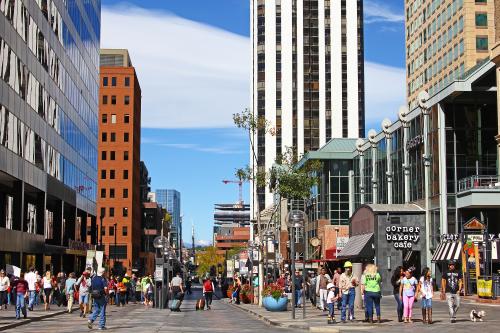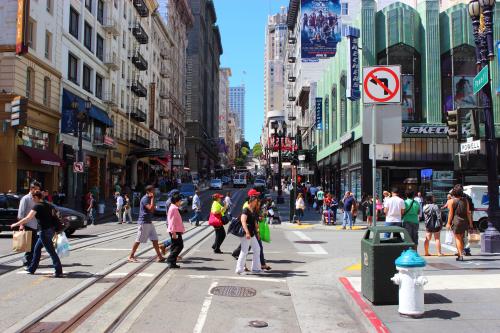Newly released census data for the first seven years of this decade signal a resumption of the population dispersal that was put “on hold” for a good part of the post-Great Recession period. The Census Bureau’s annual county and metropolitan area estimates through 2017 reveal a revival of suburbanization and movement to rural areas along with Snow Belt-to-Sun Belt population shifts. In addition, the data show a new dispersal to large- and moderate-sized metro areas in the middle of the country—especially in the Northeast and Midwest. If these shifts continue, they could call into question the sharp clustering of the nation’s population—in large metropolitan areas and their cities—that characterized the first half of the 2010s.
Suburbanization picks up
The new numbers leave little doubt that suburbanization is on the rise, after a decided lull in the first part of the decade. Migration patterns and city-suburb shifts already hinted at this trend in the last year. But the trends through 2016 and 2017 put an exclamation point on it, as seen in Figure 1.

Using a Brookings classification of counties associated with urban cores and suburban counties within large metropolitan areas, we see a continued rise in both outer exurban areas and low-density emerging suburban counties at growth levels not registered since 2008. The double whammy of the Great Recession and a mortgage meltdown seemed to have put the brakes on suburban growth, which trended downward through 2012—the peak year of the “back to the city” movement—when outer suburbs grew more slowly than urban cores. Since then, the growth of urban cores has halved and exurban county growth has quadrupled.
Revived suburban and exurban growth is most pronounced in the Sun Belt metropolitan areas. Kaufman County in suburban Dallas, Pinal County in suburban Phoenix, and Toole County in suburban Salt Lake City, Utah were among those registering highest growth. In contrast, core urban counties in the Snow Belt, including Cook Co., Ill., Cuyahoga Co., Ohio, and Allegheny Co., Pa. showed some of the greatest numeric population losses.
These suburbanization trends, while not yet at levels of the early 2000s, seem to be associated with recent improvements in the economy and housing market that have lifted the constraints to suburban relocation among potential movers, including young adult millennial households. There is reason to believe the trend is likely to continue.
Rebounding small metro and non-metropolitan growth
The lifting of mobility constraints applies to another aspect of population dispersal that was put on hold during the early part of this decade: the shift toward smaller metropolitan areas and counties outside metropolitan areas. As shown in Figure 2, non-metropolitan counties, in the aggregate, register positive population growth in 2016-2017 for the first time since 2010, and small metropolitan areas—those below half a million population—increased their rate of growth for the third straight year. At the same time, large metropolitan areas showed reduced rates of growth for two years in a row to a level of only 0.86 percent, the lowest since at least 1990.

To be sure, large metropolitan areas are still growing faster than the rest of the country. But trends are moving in the direction reminiscent of the early 2000s when small metropolitan growth exceeded that in large areas, and non-metropolitan growth was much higher than it is now. The shift toward smaller areas is evident from domestic migration statistics, based on the new data release, showing that from 2016 through 2017, large metropolitan areas lost migrants to smaller and non-metropolitan areas for the first time since 2008.
Nationally, net migration from large metropolitan areas to smaller and non-metropolitan areas was the norm for most years in the 1990s and early 2000s. In fact, marked movement from these areas to large metros was unique for the eight-year period from 2008 to 2016, covering the recession and long post-recession period. During much of this time, small metropolitan areas experienced reduced growth, and non-metropolitan areas registered unprecedented population losses. Some of the latter was due to declines in their economies, which were tied to cyclical industries, such as manufacturing and farming, with rural areas recovering especially slowly from the recession in terms of wages and employment.
Yet recent gains suggest some growth revival as the economy rebounds. From 2016 to 2017, just 1,176 of the 2,352 non-metropolitan counties lost population, down from 1,439 from 2011 to 2012. This is consistent with an analysis by my colleagues Mark Muro and Jacob Whiton which showed that in 2017, rural areas outperformed their share of the economy with respect to job growth. Although economic growth will continue to be cyclical, demographic trends point to a more normal pre-recession pattern of population shifts.
Modest gains in “middle of the country” metros
While large metropolitan areas, in the aggregate, have registered lower growth from 2016 to 2017 than in several previous years, individual metro areas vary in gains and population losses. With few exceptions, as Map 1 shows, areas located in the South and West Sun Belt regions are distinguishable as they continue to see the greatest overall population gains. However, there is also a newly emerging pattern which shows modest new gains occurring in quite a few interior metropolitan areas, where population trends have recently waned.
Map 1 depicts population gains and losses for the 100 largest metropolitan areas from 2016 to 2017 (download table). Dallas leads all others with a gain of 146,000 people, followed by other Sun Belt metros: Houston, Atlanta, Phoenix, Washington, D.C., Seattle, Riverside, Calif., Orlando, Austin, Tampa, and Miami. The only Snow Belt gainers among the top 20 are New York (15th), Columbus (19th), and Boston (20th).

At the other end of the spectrum are the 10 areas that lost population: Chicago, Pittsburgh, Honolulu, Youngstown, Syracuse, Baton Rouge, Cleveland, Toledo, Ohio, Jackson, Miss., and Rochester, N.Y. Seven of these cities are located in the Northeast or Midwest.
Yet, this single-year Sun Belt-Snow Belt distinction for population gains and losses masks a dynamic which shows up when examining changes leading up to 2016-2017. This involves modest increases in many “middle of the country” population gains that are especially notable in the Snow Belt.
The left panel of Figure 3 depicts this pattern in terms of annual growth rates for three metropolitan areas—Detroit, Dayton, Ohio, and Allentown, Pa. The first two are Midwestern industrial areas that bore the brunt of recession-related population declines, modestly reviving during this decade. Yet both showed marked upticks in growth over the last year. Allentown, on the periphery of the New York metropolitan region, was the fastest growing metropolitan area in the Northeast during parts of the early 2000s, as migrants dispersed to areas just beyond the New York region. After seeing its growth plummet from 2007 to 2013, it has inched back with a noticeable growth increase in the past year.

These “interior” metropolitan gains in the last year are symptomatic of a broader trend depicted on the map above (download table). Similar gains or reduced losses are evident for Midwestern and Northeastern areas: Akron, Ohio, Buffalo, N.Y., Cincinnati, Cleveland, Columbus, Ohio, Harrisburg, Pa., Indianapolis, Kansas City, Minneapolis-St. Paul, Minn., St. Louis, and Youngstown, Pa. The “Allentown model” of new dispersals around the greater New York region are also evident for Albany, N.Y., New Haven, Hartford Conn., Scranton, Penn., and Springfield, Mass.
Not all of the interior gainers are in the Snow Belt. Others are located in the inland California areas of Bakersfield, Fresno, Riverside, Sacramento, and Stockton; Mountain West areas of Boise, Idaho, Las Vegas, and Tucson, Ariz.; and Southeast areas of Knoxville, Tenn., Little Rock, Ark., Louisville, and Memphis, Tenn.
Perhaps just as noteworthy as modest gains of interior low-growth metros are recent reductions in population gains for some of the high flyers. Depicted in the right panel of Figure 3 are the experiences of Houston, Miami, and San Jose, Calif. All three have registered healthy population gains for much of the last decade, but have shown marked recent declines in their still high rates of growth. In fact, of the 12 areas with greatest numeric population gains from 2016 to 2017, all but two (Washington, D.C. and Riverside, Calif.) received fewer people that year than from 2015 to 2016. Moreover, among the 46 large metropolitan areas that showed smaller gains from 2016 to 2017 than in the previous year, 38 of them are located in the South and West.
This modest “filling in” of populations in interior metropolitan areas might be seen as part of a broader dispersal of the population away from urban agglomerations that have recently dominated growth. Overall, the new census statistics make clear that this dispersal is occurring on several levels. It suggests that the steady improvement in the economy and the housing market in more places, along with changing residential preferences, may be prompting employers and job-seekers to take a new look at areas that were growing before the Great Recession.







Commentary
US population disperses to suburbs, exurbs, rural areas, and “middle of the country” metros
March 26, 2018